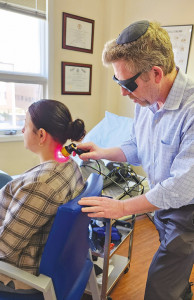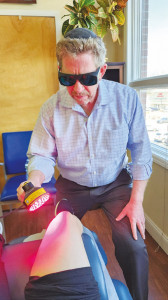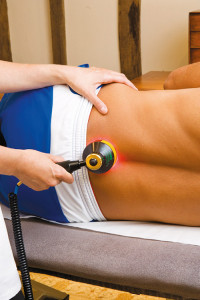
As a physical therapist for over 25 years, I have seen many innovations in technology within the realm of non-surgical joint and muscle pain relief, but one of them stands head and shoulders above the rest. Cold laser is a very powerful modality to help facilitate pain relief and reduce inflammation. I have seen firsthand the benefits of cold laser therapy for pain relief in my practice. In this article, I will shed some light on the power of cold laser therapy, including its history, evidence of efficacy, the types of light and wavelengths used, and the patients who can benefit from this therapy.
Cold laser therapy, also known as low-level laser therapy (LLLT) or more technically “photobiomodulation,” is a non-invasive treatment that uses low-intensity laser or light energy to stimulate the body’s natural healing processes. This therapy has been used for decades in physical therapy settings, but only more recently has it become the gold standard of modalities to help treat a variety of conditions, including pain, inflammation and tissue damage.
What is Cold Laser and how cold is it?

The history of cold laser therapy dates back to the 1960s when researchers discovered that certain wavelengths of light could stimulate the production of ATP, the body’s primary energy source, in cells. Since then, researchers have investigated the effects of different wavelengths of light on various biological processes, leading to the development of modern cold laser therapy. It’s all about wavelengths. Different types of light are effective for different conditions. Red light, for instance, has a wavelength of 620-750 nanometers (nm) and is effective in promoting tissue repair and reducing inflammation. Infrared light has a wavelength of 780-1000 nm and is effective in reducing pain and inflammation. The best cold laser systems have the ability to combine both red and infrared light within their application devices.
Cold laser therapy is a very safe and painless treatment option for patients. It does not require medication or surgery, making it an attractive option for many patients. There are many published studies that have demonstrated analgesic and anti-inflammatory effects provided by cold laser. The treatment is usually administered by a physical therapist or physician, who will use a handheld device to apply the laser or light energy to the affected area.
Laser therapy treatment typically takes about five to 10 minutes per session, and patients may require several sessions depending on the severity of their condition. “How cold is it?”It is not cold at all! It’s actually just room temperature. The reason the term “cold laser” took hold was to differentiate it from the more common “hot lasers” that are used for surgery or other applications. Cold lasers are usually called class 3b lasers. Hot lasers are in the class 4 range. Class 4 lasers are called hot lasers because they can rapidly increase tissue temperatures. Higher-intensity class 4 lasers can cut tissue during surgical procedures. The advantage of the cold laser is that it doesn’t generate excessive heat and therefore is painless and very safe to use on many different body parts.
Who can benefit from Cold Laser?

Cold laser therapy can help:
Reduce acute (sudden) or chronic (long-lasting) pain
Treat inflammation
Speed up wound healing
Promote tissue regrowth
Improve blood circulation
Therefore, cold laser therapy is useful for those suffering from many conditions such as chronic pain, arthritis, tendonitis, joint pain, carpal tunnel syndrome, sciatica and other musculoskeletal conditions. It is also an effective treatment for those recovering from surgery or injury, as it can speed up the healing process, speed up wound healing and reduce inflammation.
Type and quality of cold laser device is essential for best outcomes.

When exploring cold lasers and practitioners, make sure to find out the type of machine that is used for treatments. There are many devices that are on the market. Some of them are low end and relatively inexpensive and therefore do not provide the necessary power output or consistent levels of laser light. To maximize the benefits that cold laser can provide, the laser machine needs to be a high quality, calibrated machine that can produce multiple wavelengths of light, with multiple power options, and multiple probes to accommodate different body areas, from the larger muscles of the back to the very small muscles and tendons of the fingers.
In conclusion, cold laser therapy is a valuable tool for physical therapists in the treatment of pain and inflammation. Its ability to stimulate tissue repair, reduce inflammation and promote healing makes it an effective treatment option for a wide range of musculoskeletal conditions. If you are experiencing pain or inflammation, talk to your physical therapist to see if cold laser therapy is right for you.
At Back to Health Physical Therapy, we believe that in order to properly treat any musculoskeletal condition, a full and detailed evaluation by an experienced physical therapist is essential. They will then be able to determine the best treatment plan to achieve your goals. After an evaluation they will then be able to combine both cold laser treatment with a custom-tailored physical therapy program that will help you get to a place of better movement and less pain!
If you are interested in exploring whether cold laser therapy is right for you, please feel free to call the Back to Health Physical Therapy office at 201 833-0234 or visit us at bthrehab.com. We are more than happy to discuss with you the best options for your particular condition.
For more information, see our ad on page 27.
Mitch (Mordy) Simpson, PT, MSPT, OCS is the owner of Back to Health Physical Therapy located in River Edge. He is a board certified orthopedic specialist with over 25 years of experience as a physical therapist. For more information please call 201-833-0234 or visit bthrehab.com








